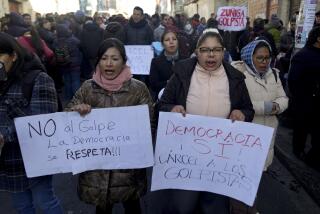Colombians in Rebel Zone Fear for Their Safety
SAN VICENTE DEL CAGUAN, Colombia — This frontier town looks pretty much the same as another one just 30 miles southwest called Puerto Rico. In both places, music blares from bars along the main drag. Pigs and cows amble through dusty streets. People crowd into roadside stores selling saddles, machetes and sides of beef.
But in Puerto Rico, the mayor was killed this week. He had replaced another mayor killed in August. Two other civil servants have been slain since June. Dozens of other residents have been shot to death.
San Vicente del Caguan sits in the center of a demilitarized zone that the Colombian government ceded to leftist rebels three years ago, and has been sheltered by a heavy guerrilla presence. Puerto Rico lies just outside the zone and has been the scene of vicious battles between the rebels and right-wing paramilitary groups.
As the United Nations and international diplomats made a last-ditch effort Friday to keep the zone intact and save Colombia’s peace process, residents here have become terrified that they may soon share the fate of their neighbors to the southwest.
Dozens of families have already fled, and one transit company has doubled the number of buses leaving the zone, a Switzerland-sized region in southern Colombia.
“As soon as the rebels leave, the army will come in, and then the paramilitaries,” one 33-year-old farmer said as he sat in the town square here Friday. “They will kill everybody.”
Fear has spread to every corner of the demilitarized zone since Colombian President Andres Pastrana broke off talks with the Revolutionary Armed Forces of Colombia, or FARC, this week, and gave the rebels 48 hours to leave the protected zone.
The army continued to send troops to surround the zone Friday as the military prepared to invade with a force of 12,000, including members of an elite rapid-deployment force.
U.N. special envoy James LeMoyne arrived in the zone Friday afternoon in sweltering heat to meet with a trio of guerrilla leaders. He has until tonight to produce a breakthrough before Pastrana officially starts the clock ticking on the 48-hour eviction notice.
The impasse began after Pastrana imposed new security restrictions in October. Accusing the FARC of abusing the zone by using it to hold kidnapping victims and train rebels, Pastrana increased air force overflights and military patrols and restricted the entry of foreigners.
Pastrana has said that the talks are over unless the FARC, the country’s largest rebel group, takes concrete steps toward peace. But rebel leaders have said Pastrana must revise the restrictions before talks can resume.
Still, after several hours of meetings Friday, both sides sounded optimistic and pledged to continue meeting today.
“We can qualify today’s work as valuable and constructive,” said Carlos Antonio Lozada, a FARC negotiator. “We have decided to agree to prolong our meeting . . . in the hopes of finding a formula to save this difficult moment that the peace process is passing through.”
LeMoyne was also optimistic.
“I hope that we will manage to make advances tomorrow. I continue hoping that it’s possible to solve this crisis,” LeMoyne said after meeting with rebel leaders Friday night.
Meanwhile, the estimated 90,000 residents of this region of rolling hills and riffling streams worried and waited. Life seemed to go on as normal. The streets in San Vicente del Caguan were filled with shoppers. Guerrillas, a common sight, could be seen walking in the town’s main shopping district, browsing a display of boomboxes.
But many of those interviewed Friday said appearances are deceiving.
“We are used to living with fear,” said one woman, a 36-year-old nurse who has worked in the region for 18 years.
Paramilitary forces entered the region about 10 months ago, according to a local human rights official. Puerto Rico, long a guerrilla stronghold, was one of their first targets as they began killing public officials.
Puerto Rico Mayor Jose Rojas was killed in August. Mayor Luis Elias Marin of nearby Cartagena del Chaira was slain in October. The new Puerto Rico mayor, John William Lozano, 34, was cut down by six bullets as he left his office this week.
Before long, rumors spread that paramilitary spies had entered the zone. That, plus the killings all around, has spread panic.
Because the zone has been controlled by the FARC, many residents fear that if the zone disappeared, paramilitary forces would go on a murderous rampage, intent on punishing a population that they believe is filled with leftist sympathizers.
San Vicente Mayor Nestor Leon Ramirez said the safety of the zone’s residents depends on the presence of officials from government and peace groups. Military forces and armed police have been barred from entering.
He said his phone has been ringing constantly the last few days as top political officials and human rights workers call to express their support. But so far, he said, the only group that has shown up is the International Committee of the Red Cross.
Leon now travels outside the zone only by air, afraid to use a car since the paramilitary forces began slaughtering public figures in surrounding towns.
“We feel abandoned here,” he said. “They must pay attention to us.”
Although many residents had hope that the peace process will be revived--something that has happened many times in the past--there was also resignation. Although the paramilitary groups are violent, the guerrillas also have committed assassinations in the zone.
“We are simply a soccer ball between the two teams,” the nurse said. “They never asked us anything when they created the zone, and they are not going to ask what they should do if they end the zone.”
Some residents said they would be trapped if the rebels are forced to leave the zone. They said they can’t leave because of the stigma of coming from the zone, which is considered guerrilla territory. But staying means facing possible death at the hands of paramilitary forces.
One distraught single mother said she wants to leave but can do nothing because she has four young children. Another man, a government worker, said he had stayed up until 2 a.m. discussing with his partner whether to leave.
In the end, they decided to stay in the hopes that the government would rescue them.
“I am afraid,” he said, “but what can I do?”
More to Read
Sign up for Essential California
The most important California stories and recommendations in your inbox every morning.
You may occasionally receive promotional content from the Los Angeles Times.










